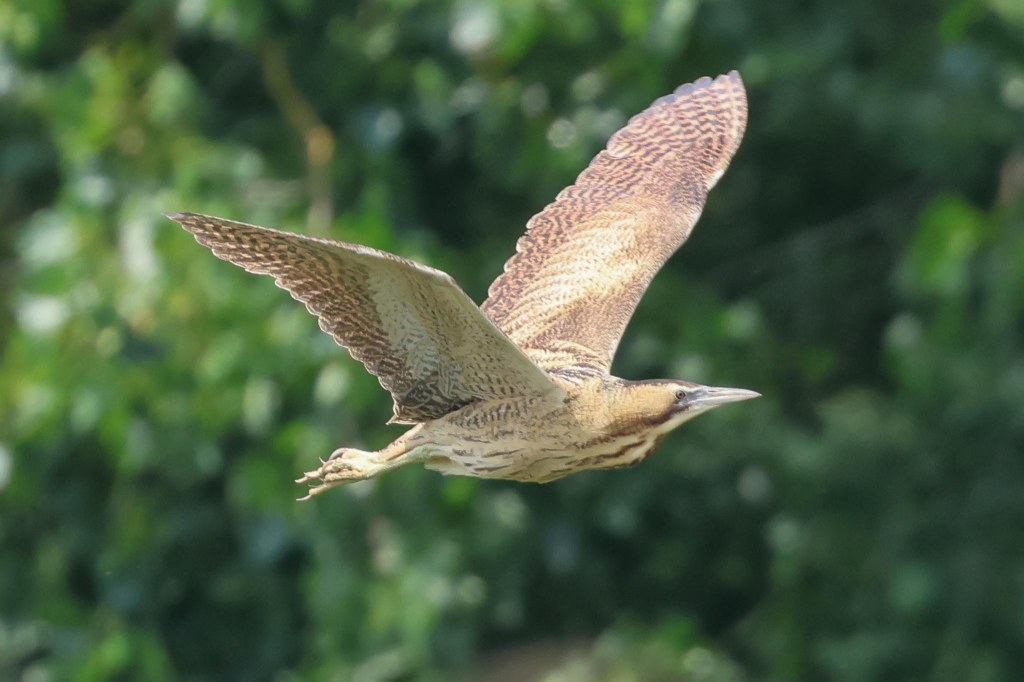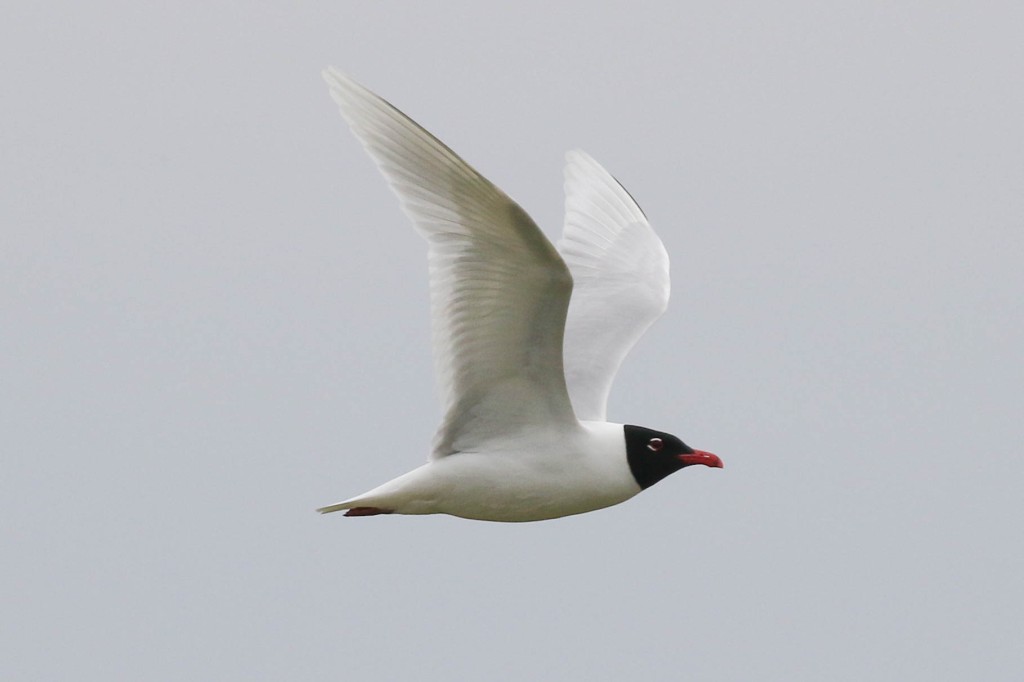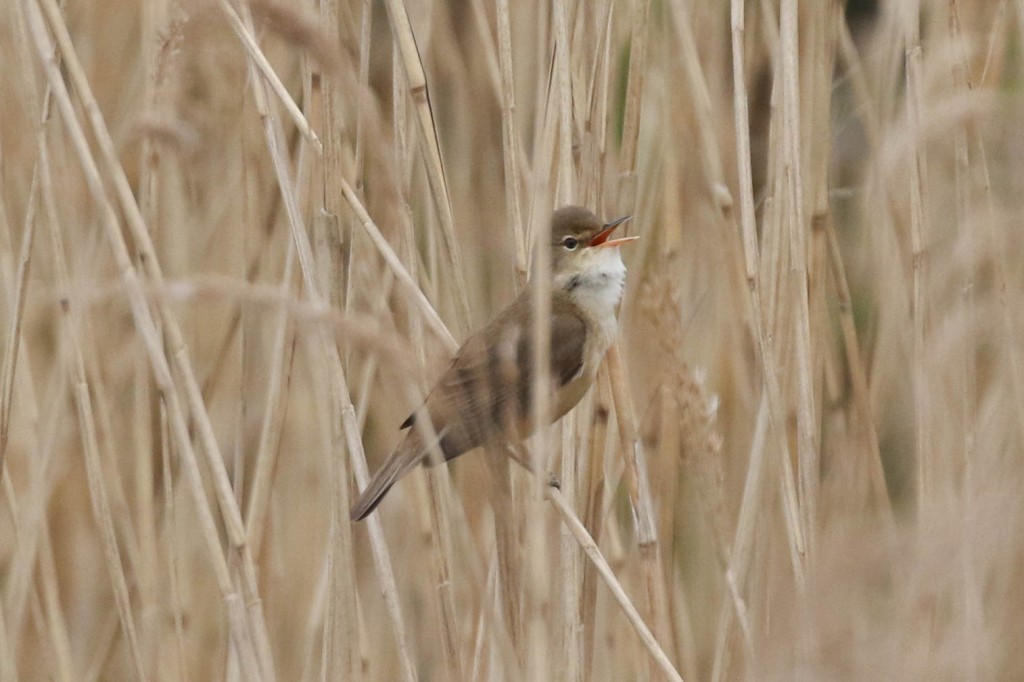A single day Group Tour in the Brecks & Fens. It was meant to be raining in the morning and then showers in the afternoon, but thankfully the rain had cleared through overnight and the only shower we saw was very brief and very light (and we were in a hide too). It was rather breezy and mostly cloudy but bright, and once again a much better day than it could have been, given the forecast.
We met in the car park at Lynford. We would normally head off first to look for Stone Curlews, before the heat haze got too bad, but one benefit from the cloud was that we needn’t hurry today, so we opted to switch things around and have a walk around the Arboretum first. A Nuthatch was calling from the trees in the car park.
Across the road, we stopped by the gate just beyond the coffee hut and scanned the garden. We could see a couple of Goldfinches and several Swallows in the trees but nothing else. A Robin was perched on the fence by the coffee hut, presumably waiting for it to open (and crumbs to be available). We could hear Siskins calling from the Arboretum itself and looking from here, there appeared to be some out in the middle towards the road, so we decided to walk in that way.
We hadn’t gone very far, when we saw a pair of Siskins chasing round through the fir trees so we stopped to see if they would land. They didn’t, but then a Spotted Flycatcher flicked out from the side of one of the firs by the path and landed on a bare branch about half way up. We had a nice view of it, as it stayed where it was for several minutes – perhaps not the most colourful of birds (brown!), but full of character and increasingly scarce these days. When it flew again, it shot over the path and up into the tree the other side. It landed face on now, so we could see its very delicate breast streaking.

There were lots of other birds here too – a pair of Nuthatches were working their way through the trees, a Goldcrest appeared next to the Flycatcher, and there were several Blue and Great Tits as well. A small flock of Chaffinches was feeding under the firs until something spooked them and they flew up into the branches. A Treecreeper flew in to a nearby trunk and worked its way up, before flying on to the next tree. We followed it briefly and realised there were actually at least two Treecreepers together.
All the birds seemed to be in the same place and as we walked on round the Arboretum, it was much quieter. A Song Thrush flew up from the ground ahead of us. We continued round past the folly and came across what was presumably the same group of birds again. A Coal Tit was calling from the firs here and there was a family of Spotted Flycatchers now, including at least two streaky juveniles which were making short flights out after insects but nowhere near as proficient as their parents yet. Back at the coffee hut, another Spotted Flycatcher was in the trees here – presumably a different bird to the family we had just been watching.

We all got into the minibus and headed over to Lakenheath Fen next. After checking in at the Visitor Centre, we headed out onto the reserve. The weather had brightened up now and there were lots of butterflies on the brambles and thistles by the path – lots of Red Admirals, several Commas, Small and Large Whites. A few Black-tailed Skimmer dragonflies were basking on the ground by the path and Common Blue and Azure Damselflies were flying in and through the vegetation on the verge. There were several Reed Warblers still singing, so we stopped to listen to one’s more metronomic song, but only one Sedge Warbler gave a very brief burst of song, not enough to compare.

We stopped at New Fen Viewpoint. The Marsh Harriers here have recently fledged and a couple of dark chocolate brown ‘copperhead’ juveniles were practicing flying over the reedbed and one landed in a small elder where we got it in the scope. Two Great White Egrets came up out of the reeds and chased each other round before dropping down again towards the back. A couple of male Reed Buntings were singing from small bushes in the reedbed – we could hear their very basic songs – and two families of Coot were out on the water.
A Kingfisher appeared briefly, hovering away to our right, over the dragonfly pool, so we walked down to see if we could find it again. A Willow Emerald damselfly in the reeds on our way was our first of the year. There was no further sign of the Kingfisher from the dragonfly platform, but a young Little Grebe standing on a small mud island looked very ungainly out of the water, and there were a few Greylag Geese and a Moorhen here too. As we turned to go, one of the group noticed a Common Lizard basking on the wooden rail and a Large Skipper butterfly was feeding on the thistles.

Back past the viewpoint, we took the small path on the edge of New Fen. There were lots of Ruddy Darters and Four-spotted Chasers in the reeds here and more Reed Warblers and Common Whitethroats calling from the vegetation. A female Marsh Harrier circled over the reedbed, three Common Buzzards and a single Red Kite drifted over West Wood. At the far end, we could see one of the Great White Egrets feeding in the shallow pool in the reeds.
It was a bit breezier along the path beyond, towards Joist Fen Viewpoint. A juvenile Great Crested Grebe was on one of the pools by the path, but otherwise there was not much of note so we pressed on. We had brought our lunches with us today, so we sat and ate while we scanned. It is a lovely spot to sit and watch the world, but there was not much activity here today. The usual Cormorant wasn’t on its post when we arrived but flew in shortly after. There were another couple of Great White Egrets out here, one of which flew in at one point and landed on the pool right in front of us. A single Hobby drifted over and off towards the river.

We were mainly hoping to catch up with Bitterns and Cranes here, but both were proving to be elusive. We did hear Common Cranes bugling, but they were distant and did not fly up so we could see them. This is normally a great time of year to see female Bitterns on feeding flights but they have not been as active as usual this year. It may be there are fewer nests in 2023 (the wardens had been meant to be Bittern surveying today, but they had called it off due to the same weather forecast we had seen for rain this morning!), fallout from some areas of the reserve drying out last summer affecting where they are feeding, or some other reason. Eventually, we did see a Bittern fly across out over the reeds before it dropped down into the edge of the ditch.

We decided to walk back to Mere Hide. There were a few dragonflies basking on the path ahead of us as we walked and then we happened to look down at one point to see a clearwing moth right in front of us – it looked chunky, with three obvious yellow bands on its black abdomen. It looked just like a Dusky Clearwing! Unfortunately we were too close and it flew before we could get any photos. Dusky Clearwing had not been recorded in the UK since 1924, until it was found in Warwickshire last year and this year has been found in numerous other places, attracted to pheromone lures, including at Lakenheath Fen. Has it been hiding in plain sight all this time? Regular readers of this blog will know that we saw one in Romania just last month, so we should know what we are looking for. Shame we didn’t see it earlier.
When we arrived in the hide, we were told that we had just missed a Kingfisher, which had been on one of the perches right in front of the hide for 10-15 minutes. Never what you want to be told! There were not many other birds here, apart from a couple of young Coot, so we spent a few minutes watching the dragonflies, including several Emperors – an electric blue male patrolling up and down along the edge of the reeds and a couple of greener females ovipositing in the vegetation on the edge of the water.
A Kingfisher called away to our left and the members of the group at that end of the hide looked out of the far window to see it land right on a perch below. It was only a couple of metres from the hide. We all crept up quietly but it seemed totally unconcerned by all the people staring at it. It turned round so it was front on, scanning the water, then launched itself down and came back up with a couple of small fish in its bill, bashing them on the perch. It flew but landed on another perch right in front of the hide now. Close enough for phone photos! It was a male, with an all-black bill.

Over the space of 10-15 minutes, the Kingfisher delighted us with some amazing close views. It moved from perch to perch, occasionally diving into the water, sometimes coming up with a fish, sometimes coming up empty-billed, showing us all sides. Everyone in the group agreed it was the best views of Kingfisher they had ever had, and it seemed to be endless. Then we heard another Kingfisher call to our left and looked out of the side window to see a second bird shoot low over the water in a flash of electric blue and disappear behind the sallows. Presumably the female, the male took off from its perch and flew, following it round behind the trees and out of view. What an amazing spell.

Elated, we set off back to the Visitor Centre, where we rewarded ourselves with ice creams. Having not seen the Cranes here, we decided to have a quick drive deeper into the Fens to see if we could find them in the fields nearby. A Corn Bunting was perched in the top of a bush by the road, still a regular breeding bird here, and there were several Yellowhammers singing ‘a-little-bit-of-bread-and-no-cheese’ too. A male Marsh Harrier was perched on a fence post preening and a Peregrine drifted over. When we got to the most likely fields, where we have seen them in the past, they were very overgrown and then we found a tractor out in the middle of one, presumably topping them. There was no sign of any Cranes.
Our last target for the day was Stone Curlew, so we drove back to Weeting and called in at the NWT reserve. The Stone Curlews have been showing very well this year, and after fledging two young already they are now having another go. Out at West Hide we could immediately see one preening in the cultivated area in front of the hide – nice views again, and with it still being cooler with high cloud there was still no heat haze.

The wild flowers are growing up now, which makes it even harder to see them when they are sitting down, but looking carefully we could just see a striking yellow iris through the scope scaring back at us, the second Stone Curlew. The nest camera is a bit of a giveaway! We sat for a while and watched them, the off duty bird preening, then settling down into the flowers where it was harder to see. We could see a little patch of dark clouds approaching and it started to rain. The Stone Curlew stood up and made a dash towards the trolley with the solar panels – was it trying to get out of the rain? It stood by it, looking round, then settled down again.
A nice way to finish the day, we packed up and headed back to Lynford where we said our goodbyes.





















































































